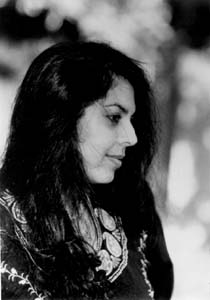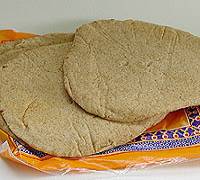LITR 4333: American
Immigrant Literature

Student Poetry Presentation 2003
Poetry
presentation: Chitra Banerjee Divakaruni, “Restroom,” UA
21-23
Reader: Jana Jensen
Respondent: Lori Nolen
Recorder: Jeanette Smith


“The
Restroom”
Biographical Information:
Chitra
Divakaruni was born in Calcutta and spent the first nineteen years of her life
in India. She moved to the United States to continue her studies, getting a
Master's, and a Ph.D., both in English.
Her work
explores the immigrant experience through Indian women in American cities.
 Vocabulary:
Vocabulary:
Chapatis- pancake-like
breads usually made from whole-wheat flour and water. The dough is rolled into
thin rounds and baked on a griddle, usually without oil, to form small cakes.
(tortillas)
Bajra-
food grain crop in India (used to make Chapatis
Literary
Terms:
Interior
Monologue – mode of narrative intended to reveal to the reader the
subjective thoughts, emotions and fleeting sensations experienced by a
character. (p. 218)
Stream
of consciousness- type of interior monologue; shows the flow (or jumble) of
thoughts and sensory impressions that pass through the mind each instant. (p.
456)
Objectives:
Stage 2: Journey
to the New World- The speaker experiences her journey on a cramped plane
uncomfortably seated next to a large stranger. She has to bite her teeth
together to keep from crying and compares it to morning sickness.
Stage 3: Shock,
Resistance, Exploitation- She experiences shock to all the “pale men.”
Her husband is exploited as an
Indian in a bad part of town. He is
robbed and shot.
The Speaker’s only recognition
is the word “hospital” and the women’s restroom sign.
Cultural objectives
1a –American Dream –immigrating
to America for personal freedom and economic betterment.
The speaker and her husband have come to America to make a better life
for themselves in owning their own business and making “good money.”
Maybe they can even afford to bring their daughter over and have another
child?
1b Socioeconomic Immigration
– economic failure leads them to immigrate to America.
She once dug in the fields, ground bajra and cooked for 12 people with no
stove or running water. Now she can
work in her own store and make her own money.
Interpretation:

This prose poem features an
Indian-born woman torn between old and new world values. Her character is filled
with fear, hope, and discovery.
After a torturous flight and
confusing arrival, she is met with a disaster: her husband has been shot and
robbed and is in the hospital. She
is shaking, her head hurts, chest is tight, she can’t speak.
Then, unable to ignore the pain
of her swollen bladder, she quickly finds the restroom where new and innovative
amenities await her “like in a fairytale.”
She is now comforted by the
women’s voices. And the shiny faucets with running warm water fill her with
hope.
In an interview in 1999, she was
asked about the last line of “Restroom” containing a sense of hope.
To this she responded: “I
think so. I also think that in many of my poems there is always that hope
because that's how I see the life of these women, including myself. That there
is a lot of hardship but there is spiritual strength in the women.”
Discussion
Questions:
1.
What do you think the “redness” is that she speaks of?
After hearing
that her husband has been shot and is in the hospital:
“I keep my eyes open so the redness
won’t cover me.”
While in the
restroom:
“The redness is far now”
2.
Why would a water faucet give this woman hope?
What does it symbolize to her?